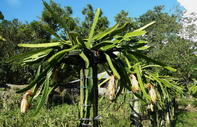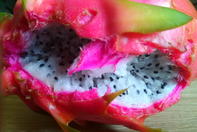Dragon fruit farming is done worldwide, where the climate for these tropical cacti is suitable. This includes South Africa, where the export production of these huge scaly fruits is growing enormously. Vietnam is the world’s biggest producer of dragon fruit, also known as pitaya.

How to Farm Dragon Fruit
Dragon fruit is best propagated from cuttings.
The plants prefer well-drained and composted soil in warm areas with a rainfall of at least 400 mm and up to 1 500 mm per year. High-density planting of up to 1 250 plants/ha is easily managed, with a spacing of 4 m x 2.5 m to 5 m x 2.5 m, depending on trellising systems.
The thick fleshy stems can grow up to 4 m, in a single growing season and must be trained and tied onto a single pole or trellis system of about 1.8 m high. Precast concrete poles are widely used and three to four plants can be trained onto one pole.
Under South African conditions, especially in areas with an annual rainfall of lower than 400 mm per year, irrigation of dragon fruit is advised; irrigation might produce larger fruit.
Dragon fruit responds well to soil and foliar fertilising.
Pollination of Dragon Fruit Flowers
The large scented dragon fruit flowers bloom only for one night and are naturally pollinated by nocturnal pollinators like bats and moths. It was found that hand pollination of dragon fruit flowers can increase fruit size, but in South Africa, bees contribute to the pollination of dragon fruit. Flowers start opening at 18:00 and only close at 11:00 the next morning, leaving enough time for bees to utilize the rich pollen source of dragon fruit flowers. The flowers are up to 30 cm in size containing about 100 g of pollen, thus combining dragon fruit with bee farming can be a viable option to diversify a farming system, with the additional advantage of increased pollination, advises Max van Heerden of Dragon Fruit South Africa.
Light and climate stimulate flowering and dragon fruit needs 12 - 14 hours of light daily, so artificial lighting may be used to increase flowering. In South Africa, this is impractical and expensive, but some trials with additional lighting are done at Amorentia Estate & Nursery in Limpopo. An extra two to three hours of artificial light is employed in countries (e.g. Vietnam) where cloud cover during summer limits sunlight exposure.
Pests and Diseases of Dragon Fruit

Dragon fruit plants are sensitive to intense sunlight, frost and over-watering or waterlogged soil. Of course, animals like livestock, birds and monkeys love the fruit and leaves, and some dragon fruit plantings are under shade net to protect ripening fruit from birds and hail damage. In South Africa, shade-netting is not widely used.
South African research focuses on pest and disease control in dragon fruit farming.
Pests include mites, thrips, ants, scale insects, mealy bugs, beetles, slugs, borers, nematodes, fruit flies and rodents.
Dragon fruit diseases include stem rot, Anthracnose (causing red-brown lesions) and fungal pathogens such as Fusarium spp. and Aspergillus spp. In addition, dragon fruit is a fruit fly host and irradiation or hot air treatment may be used for disinfestation. In South Africa, fruit fly baiting is effective.
The biggest quality issues with export dragon fruit are bruising and fungal infections associated with over-ripe fruit.
Harvesting of Dragon Fruit
As the fruit develops, it starts changing colour at 26 - 30 days after pollination. It should be ready to harvest in about 30 to 34 days, a few days after the fruit has changed colour.
A common index for dragon fruit ripeness includes skin colour, total acids and sugar level (measured in ºBrix) but a good balance between acidity and sugar level ensures optimal taste, says Howard Blight of Amorentia Estate & Nursery in Limpopo.
After harvesting by hand, dragon fruit is washed in a food-grade disinfectant and size-graded by weight. The fruit is then sorted according to superficial damage, e.g. ants or fruit flies, shrivel, skin colour as well as the colour and condition of the bracts (‘scales’).
The plants bear fruit two years after planting and is in full production within five years. Depending on the cultivar and condition of the plantings, yields of 15 to 35 tonnes/ha can be expected.
Post-Harvest Processing of Dragon Fruit
Export dragon fruit can be packed in white polystyrene netting, similar to papayas, wrapped in paper, packed into flat cartons or into punnets. For en-mass displays in shops, dragon fruit can be bulk-packed to 10 kg.
Dragon fruit can have a shelf life of two weeks if stored at around 10ºC. For export, dragon fruit should be kept at 3ºC to 5ºC for a shelf life of between 27 and 42 days.
The optimum relative humidity is at 85% - 90%. Shelf life can be extended by using controlled atmosphere during cold storage, while modified atmosphere bags can extend the shelf life of dragon fruit to up to 42 days.
If dragon fruit is overripe, for example, class III fruit, it can be processed into juice and fruit pulp, which can be used for value-added products such as wine, fruit rolls and jams. Eateries like Kauai and Starbucks use dragon fruit for smoothies and ‘refreshers’.
By Marinda Louw